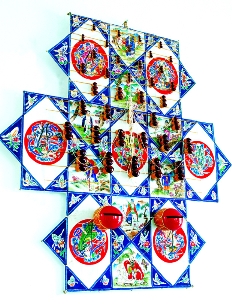Workmanship of Nantong Banyao kites

Nantong Banyao kite [Photo/ntsfy.cn]
There are two kite genres in China – “Yuan” in the north and “Yao” in the south. Unlike the kites in the north of China, the kites in the south have no sculpted shape and are mostly flat.
The Nantong Banyao kite is a typical southern flat kite. The big ones are about eleven feet, while the small ones are only about one foot. The kites are in different shapes, such as square, rectangular, hexangular and octangular. The hexangular kites are the majority. They have six convex angles; a rectangle is intersected with a square to form the hexangular shape. Different types of kites, such as the “seven-star kite”, the “nine-star kite” and the “nineteen-star kite”, are also formed by creating such geometric figures.
The most outstanding feature of the Nantong Banyao kite is its whistles. The distance between whistles is well-proportioned, with odd and even numbers on each line. They are always on a vertical, horizontal or oblique line. The whistles are connected with strings and fixed back and forth, top and bottom, and right and left. They are arranged in a crisscross pattern like musical instrument strings, which improves their sound and enhances their beauty of form. When the kite is flown, the whistles start to make a musical sound in the wind.
The origin of the Nantong Banyao kite is uncertain. There are three main different stories. The first one is about weather forecasting to assist farmers’ labor. This theory is found in the article “The Kite Detecting Wind” written by farmers, which is recorded on the book Nantong History Notes. The laborers in the salt industry can forecast wind and rain by listening to the whistle of the Banyao kite, finding out the wind’s speed and direction, predicting sunny and rainy days and measuring humidity. When fishermen are at sea, they can use the kite as a sky lantern, making signals to port. The kites can also be used to check wind direction and power to determine when to weigh anchor, or stand out to sea.
The second story is about the legend of Zhang Liang and Han Xin in the Western Han Dynasty (206 BC – AD 24). Since ancient times, Nantong has been known for the “iron kite” made by Zhang Liang and Han Xin. It is said that the “iron kite” was sent up with iron rope and was used to carry people into the sky. According to the legend, Zhang Liang flew on a kite from Tongzhou district to Hangzhou, to meet his wife and daughter who were farming sesames below. It is even said that the iron rope still exists in the well under the incense burner in the front of the shrine of Beishangzhen Temple on the north end of Nantong.
The third one is about consecrating gods, praying for blessings and avoiding misfortunes. People prayed to deities for happy lives, high position and great wealth with the help of the kite pictures and for world peace with the help of roaring whistling to frighten demons.
The Nantong Banyao kite can mainly be found in the various townships of Nantong, such as Zhadong town and Zhaxi town of Gangzha district.


